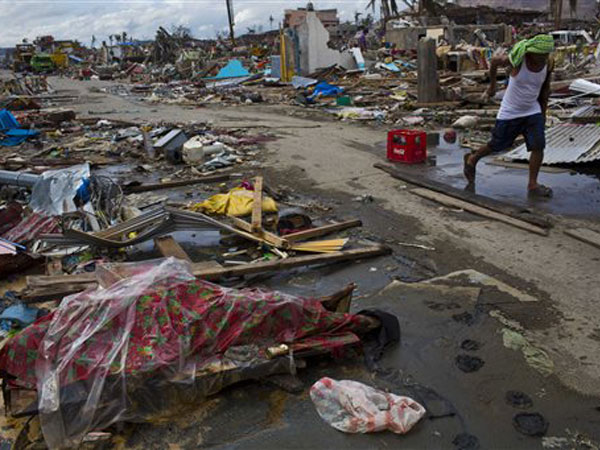
A Typhoon Haiyan survivor walks past a dead body, wrapped in plastic Christmas theme wrapping in Tacloban on Saturday Nov. 16, 2013. One week after Typhoon Haiyan razed the eastern part of the Philippines, leaving 600,000 homeless, survivors have begun rebuilding, with or without help from their government or foreign aid groups. AP
MANILA, Philippines – The National Disaster Risk Reduction and Management Council (NDRRMC) on Sunday said at least 3,681 were killed during the onslaught of super typhoon “Yolanda.”
NDRRMC spokesperson Major Reynaldo Balido Jr. told Radyo Inquirer 990AM that at least 3,681 bodies have been recovered from typhoon-hit areas while 1,186 people were reported missing. Meanwhile, at least 12,544 people have been injured.
With retrieval operations on-going, more bodies are expected to be found.
Read: ‘New dead’ found under rubble
The NDRRMC death toll breached the 3,000-mark on Friday, two days after the President told CNN that the government estimated a death toll of 2,000 to about 2,500.
Read: Aquino says ‘Yolanda’ death toll closer to 2,500, not 10,000
Still unidentified
“Karamihan dyan ay halos hindi pa identified. Alam naman natin matindi ang naging devastation. At may mg kaso na buong pamilya (ang namatay) at wala nang nagbibigay ng pagkakakilanlan sa mga katawan na iyan,” Balido said.
(“Many of the bodies have not yet been identified. We know the typhoon’s devastation was tremendous. There were instances when whole families (were killed) and there’s no one to identify the bodies,” Balido said.)
Most of the unidentified bodies are from Samar and Leyte in Eastern Visayas, he said.
For the other regions, names of the fatalities have already been reported. The list is regularly updated and posted in the NDRRMC website (www.ndrrmc.gov.ph), together with a daily report on the aftermath of “Yolanda.”
Balido said the local government units in Eastern Visayas have yet to submit the names of the reported casualties from what is now considered the world’s strongest typhoon of the year.
“Local leaders from Region 8 submitted figures but there were no names…But we will require them. We will request them to submit immediately,” he said.
Mass graves
The NDRRMC spokesperson said a number of the unidentified corpses have already or will have to be buried immediately.
“Local chief executives have already identified mass grave sites,” he said.
However, Balido said the bodies are properly buried, contrary to the notion that the corpses are thrown into a single grave.
“Each body is assigned a separate grave,” he said.
Although the bodies are unidentified, he said the Department of Health and other concerned agencies will put markings on the graves so relatives may later find them.
Through DNA testing and other techniques, authorities may still match the corpses to relatives looking for them.
“The graves will be shallow so that the bodies can easily be retrieved,” he said.
Typhoon “Yolanda” affected 3.9 million people and damaged 543,127 houses. Total damage to agriculture was pegged at P9 billion while cost of destroyed infrastructures was at P1.25 billion.
RELATED STORIES:
Spiritual balm for weary souls: Catholic group gives rosaries
Outpouring of support for ‘Yolanda’ survivors
CNN, BBC, int’l media slam Aquino for ‘disorganized’ Yolanda aid response
Anderson Cooper to Korina Sanchez: Go to Tacloban